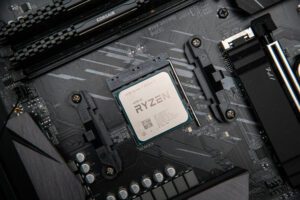Introduction
In today’s fast-paced world, technology plays an integral part in our daily lives, and choosing the right device for our computing needs can be a daunting task. When it comes to personal computing, the two most popular options are laptops and desktops. The eternal debate between these two devices continues to ignite curiosity and spark discussions. In this blog post, we will delve into the intricacies of laptop and desktop computing, shedding light on the factors that can help you make an informed choice. By unmasking the pros and cons of each option, we hope to guide you in making the right decision that aligns perfectly with your computing requirements.
Portability: Laptops Lead the Way
In an increasingly mobile world, portability has become a key factor in choosing a computing device. Laptops have emerged as the frontrunners in this regard, offering unparalleled convenience and flexibility. Their compact and lightweight design makes them ideal for users who are constantly on the move.
Laptops provide the freedom to work, study, or entertain yourself from anywhere, whether you’re in a coffee shop, on a plane, or simply moving between different rooms in your home. With their built-in batteries, you can easily go cordless and stay productive on the go without worrying about finding an electrical outlet. This portability factor is particularly beneficial for digital nomads, students, and professionals who require a device that can keep up with their dynamic lifestyles.
Moreover, laptops come with a built-in display, keyboard, and trackpad, eliminating the need for external peripherals. This all-in-one design further enhances their portability and convenience, as you can simply open the lid and start using your laptop without any additional setup.
While desktops have made strides in reducing their size and weight with compact form factors, they still can’t match the portability offered by laptops. Desktop computers are typically stationary and require a dedicated workspace, making them less suitable for those constantly on the move.
In the realm of portability, laptops clearly lead the way, providing users with the freedom to work and play wherever they go. However, it’s essential to consider other factors before making a final decision, as laptops’ portability does come with certain trade-offs. Let’s explore further to uncover the complete picture.
Power and Performance: Desktops Take the Crown
When it comes to raw power and performance, desktops have a clear advantage over laptops. Desktop computers feature larger form factors that can accommodate better and more powerful components, enabling them to handle resource-intensive tasks with ease.
Desktops typically come with faster processors, more RAM, and dedicated graphics cards, making them ideal for tasks like gaming, video editing, and 3D rendering. These tasks require high processing power and can put a strain on a laptop’s cooling system, resulting in reduced performance and overheating.
Moreover, desktops allow for greater customization and upgradability, which means you can swap out or add components to enhance your device’s performance. With a desktop computer, you have the flexibility to tailor your system to your specific needs and preferences.
While laptops have come a long way in improving their performance and power, they still can’t match the raw computing power of desktops. In addition, the compact design of laptops limits their upgradability, as most components are soldered onto the motherboard and can’t be easily replaced.
So, if you’re someone who requires a device that can handle demanding tasks, a desktop computer might be the better choice for you. However, it’s essential to consider other factors, such as portability and ergonomics, before making a final decision. Let’s explore these factors further to understand the complete picture.
Ergonomics and Comfort: The Desktop Advantage
In the realm of ergonomics and comfort, desktops have a distinct advantage over laptops. The design and setup of a desktop computer allow for improved ergonomics, which can have a significant impact on your overall comfort and long-term well-being.
Desktop setups typically feature larger monitors that provide a more immersive viewing experience and reduce eye strain. The larger screens also allow for better multitasking, as you can have multiple windows or applications open simultaneously without sacrificing readability or screen real estate.
Furthermore, desktop keyboards and mice are often more ergonomic than their laptop counterparts. They offer better key travel, spacing, and wrist support, promoting a more comfortable typing and navigating experience. This can be particularly beneficial for individuals who spend extended periods typing or working on their computers.
Desktops also allow for flexible monitor positioning. You can adjust the height, tilt, and orientation of the monitor to achieve an optimal viewing angle, reducing neck and back strain. Additionally, a desktop setup can accommodate external accessories such as ergonomic chairs and adjustable desks, further enhancing your overall comfort and posture.
On the other hand, laptops, with their compact design, can sometimes compromise ergonomics. The smaller screen size and built-in keyboards and trackpads can lead to cramped hand positions and discomfort during extended use. While external peripherals can be connected to laptops to improve ergonomics, the overall experience may still fall short of a dedicated desktop setup.
Considering the importance of ergonomics and comfort for long-term usage, desktops offer a clear advantage. However, it’s essential to weigh this factor against other considerations, such as portability and power, to make a well-rounded decision. Let’s explore these factors further to gain a comprehensive understanding.
Upgradability: Desktops Offer Flexibility
One significant advantage that desktops have over laptops is their upgradability, providing users with greater flexibility and longevity for their computing needs. Unlike laptops, which often have limited upgrade options, desktop computers offer the ability to replace or upgrade individual components as technology advances.
With a desktop, you have the freedom to upgrade the processor, graphics card, RAM, and storage devices according to your requirements and budget. This allows you to keep up with the latest advancements in technology and ensure that your system remains capable of handling new software and demanding tasks.
Upgrading components in a desktop computer is relatively straightforward, as the internal hardware is more accessible and standardized. You can easily open the case, swap out old components, and install new ones without much hassle. This flexibility gives you the power to customize your desktop to your specific needs, whether it’s for gaming, graphic design, or other computationally intensive tasks.
Additionally, desktops often offer more storage options, including multiple hard drives and solid-state drives (SSDs). This means you can easily expand your storage capacity or upgrade to faster storage solutions without sacrificing existing data or reinstalling the operating system.
In contrast, laptops are generally more limited in terms of upgradability. Many laptop components, such as the processor and graphics card, are soldered onto the motherboard, making them difficult or impossible to replace. While some laptops allow for memory and storage upgrades, the options are typically more restricted compared to desktops.
Considering the benefits of upgradability, desktops provide users with the freedom to adapt and improve their systems over time. This is particularly advantageous for individuals who anticipate their computing needs evolving or who prefer to invest in a long-term solution. However, it’s important to evaluate other factors, such as portability and price, to make an informed decision. Let’s delve into these factors further to gain a comprehensive understanding.
Price Considerations: Laptops Offer Affordability
When it comes to price considerations, laptops often offer a more affordable option compared to desktops. While there is a wide range of laptops available across different price points, budget-friendly options can be particularly enticing for cost-conscious buyers.
Entry-level laptops are generally more affordable and can still provide sufficient performance for everyday tasks such as web browsing, document editing, and multimedia consumption. These laptops often come with integrated graphics and modest processing power, making them suitable for casual users, students, or individuals with basic computing needs.
Furthermore, laptops offer a complete package with built-in displays, keyboards, and trackpads, eliminating the need for additional expenditures on external peripherals. This bundled convenience can make laptops a more budget-friendly choice, especially for users who are starting from scratch or have limited space and resources.
On the other hand, desktops, while providing superior performance and upgradability, often come with higher upfront costs. Building a custom desktop setup with high-end components, dedicated graphics cards, and expansive storage solutions can significantly increase the price. Additionally, desktops require additional investments in peripherals like monitors, keyboards, mice, and speakers.
However, it’s important to note that while laptops may be more affordable initially, their limited upgradability can result in a shorter lifespan compared to desktops. Upgrading a desktop in the future can be a cost-effective approach to keep up with evolving technology, potentially extending the lifespan of the system.
Ultimately, the decision between a laptop and a desktop should consider both upfront costs and long-term value. Assess your budget, computing needs, and anticipated usage to determine whether the affordability of a laptop aligns with your requirements or if the long-term investment in a desktop is a more suitable choice.
By considering the price factors alongside other aspects like portability, power, and ergonomics, you can make an informed decision that strikes the right balance between affordability and performance.
Conclusion
In conclusion, when deciding between a laptop and a desktop, it’s essential to consider your individual needs and preferences. Both options have their distinct advantages and limitations, and the final choice should align with your computing requirements, budget, and lifestyle.
Laptops offer unmatched portability, making them ideal for individuals who need to work on the go or switch between locations frequently. They are also generally more affordable, and their bundled convenience can be appealing to those starting from scratch or with limited space and resources.
On the other hand, desktops provide superior power and performance, thanks to their upgradability and customizable components. They also offer ergonomic benefits, allowing users to configure their workstation for maximum comfort and productivity.
Ultimately, the choice between a laptop and a desktop comes down to your priorities. If portability and affordability are critical factors, a laptop may be the ideal option. However, if power, upgradability, and ergonomics are your top concerns, a desktop may be the better choice.
By weighing the pros and cons of each option, you can make an informed decision that fits your unique computing needs and budget.



